Gradient manicure: what is, types and design
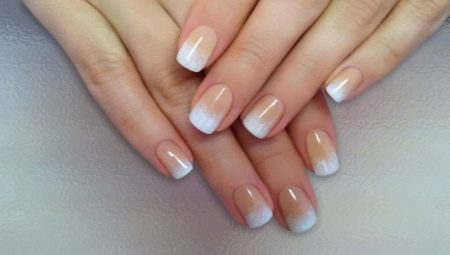
Each new season brings new trends in the nail industry, however, gradient shades have been at the peak of popularity for several years. The very structure of such a coating is a bright combination of several tones without a pronounced sharp transition between them; this style allows you to fantasize and implement the most creative combinations in wardrobe and accessories.
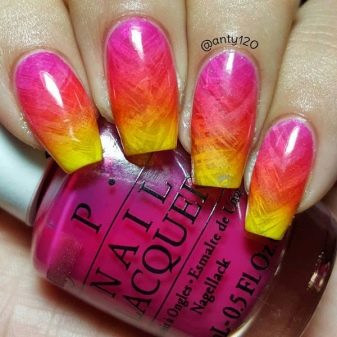
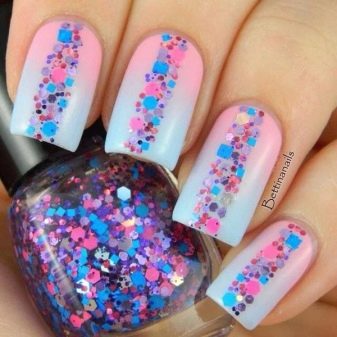
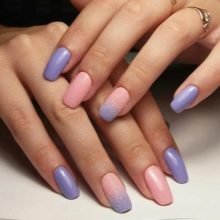

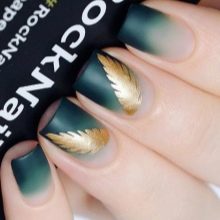
What?
From a technical point of view, a gradient, or, as it is also called, degradation, is a soft transition from one tone to another, and stretching in it can be carried out not only from light to darker shades of one color, women of fashion sometimes choose absolutely different colors and try to beautifully combine them with each other. This is precisely one of the main advantages of such a coating - the combination can be any, rather unexpected and original; all this allows the girl to stand out and, without a doubt, impress others. There is another plus, much more practical - when several tones are collected on the nails, it is always easier to choose an outfit so that it creates a single image with a manicure.
Quite often, the gradient is accompanied by the use of additional decorative elements, for example, glitter, beads or small stickers - all this allows you to make a truly exclusive design.
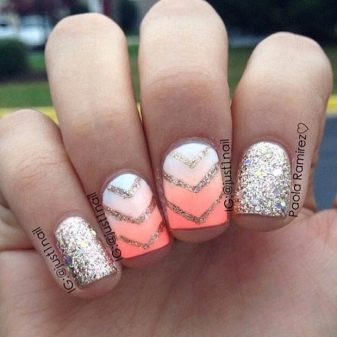
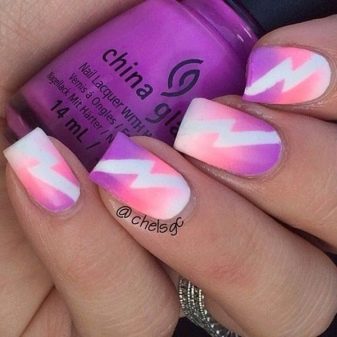
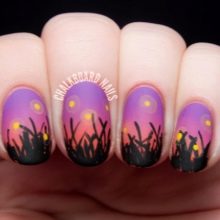
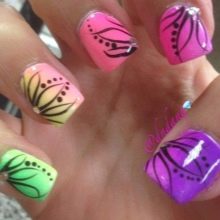
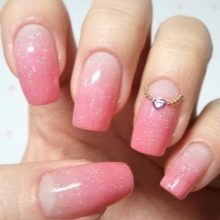
Stylists highlight a few more advantages of applying ombre:
- soft transitions from tone to tone provide fertile ground for bold experiments;
- such a design, which includes several colors, always attracts increased attention;
- absolutely any colors and shades can be used for a gradient;
- the coating goes well with additional decorative accessories;
- you don't need to repaint your nails every time you change your outfit;
- depending on the chosen colors, the gradient can be appropriate both at a gala event and in an office with a strict dress code.
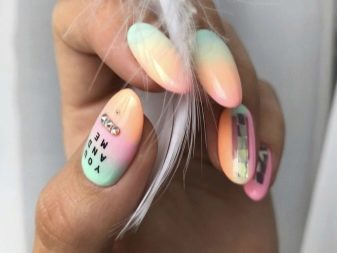
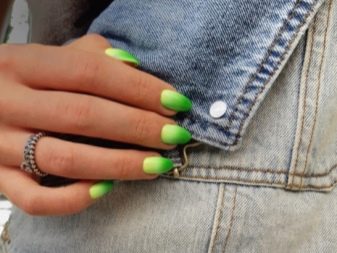

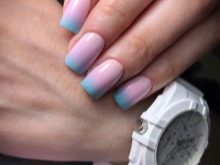
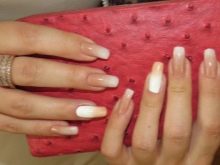
Of the shortcomings, perhaps only one can be noted - not all colors harmonize well with each other and not every shade can flow beautifully from one tone to another. But all this is just a matter of taste: if a woman is brave and is not afraid of bright colors, then she will be able to turn any combination into her zest.
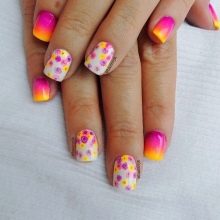

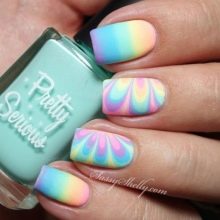
Varieties
A gradient is often referred to as a stretch and is usually drawn in several ways. Depending on the coating technique, manicure options are divided into several types, let's dwell on them in more detail.
- Gradient manicure - such a technique of covering the nail plates, when one shade imperceptibly flows into another. Such a manicure is better known as ombre and, as a rule, one color is used for such a design, only its shades change in the direction from light to slightly darker.
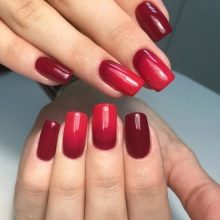
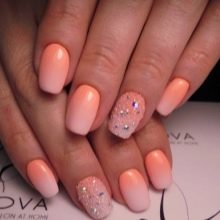
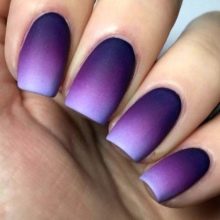
- An alternative to it is the so-called Dip Dye manicure, when coloring is in several different, but always bright shades.
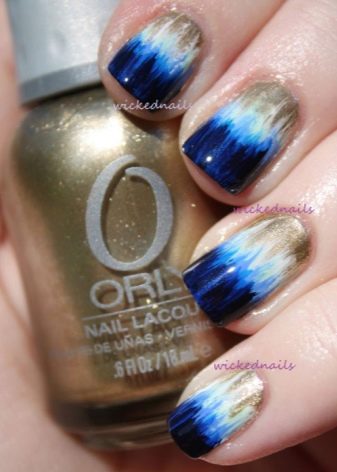
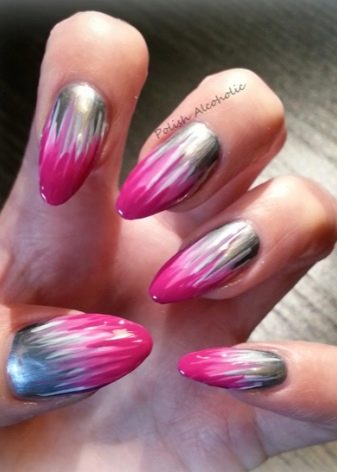
- Besides, graduation manicure divided into horizontal as well as vertical, and a gradient with a transition is highlighted. Of course, every season there are more and more new options for such a stylish coating, but the classics always remain at the peak of popularity.
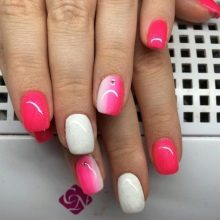
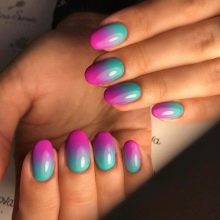
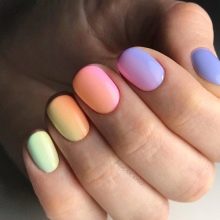
The easiest way to apply is a gradient with a transition. Usually, for the execution of such a coating, 5 coatings are selected and, in turn, each one covers the nails from the big to the little finger. Thus, the stretching of tones is obtained from one finger to the other. Such a manicure is quite easy to do on your own, and if you do not have five varnishes of different tones on hand, you can always make a new color yourself - for this it is enough to mix several colors, for example, red and yellow give orange, yellow and blue give green, and pink with purple - a pleasant lilac shade.
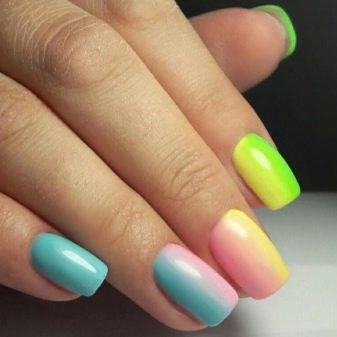
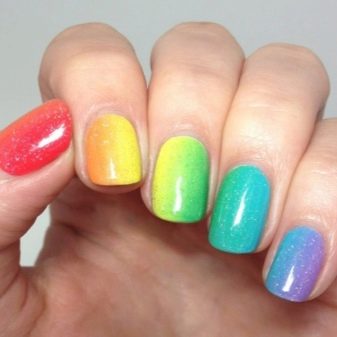
Experienced craftswomen sometimes even manage with two varnishes, for example, you can prepare blue and white coatings.
Cover the first nail with blue, and to stain the second, drop a little of this blue varnish on a glass or plastic palette and add a little white to it so that the shade becomes a little lighter. You need to cover the second plate with this color, and then add another drop of white to the palette and paint the third nail. Thus, you will get a transition from blue to pale blue, while you can paint all 10 nails with a gradient or cover the nails on both hands the same way, or you can arrange the nails on one hand from blue to white, and the other can be done in the same way, but mirrored.
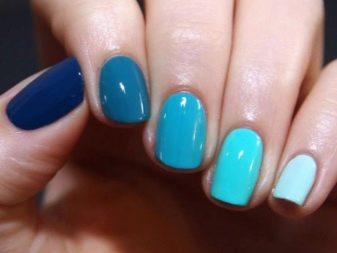
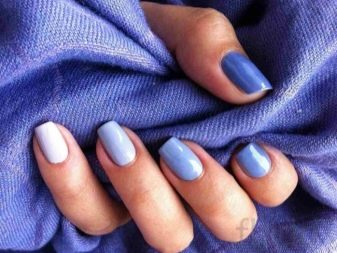
Horizontal and vertical transitions are a little more complicated, they represent a stretch from one color to another.
Horizontal ombre assumes the transition of tones from the very tip of the nail to its cuticle, while the shades are both "related" and completely different. In the first case, the manicure will be gentle and classic, in the second - bold and extravagant.
Usually, at least three shades are used in such a manicure, and experienced craftsmen apply even more colors. At the same time, keep in mind that if you use many shades in a contrasting ombre, the transition will be quite sharp, and if you use similar shades, then the overall look will, on the contrary, be soft and delicate.
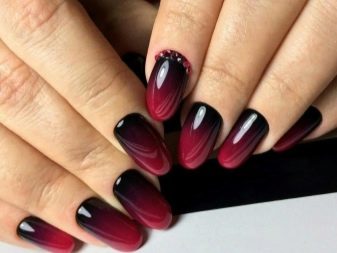
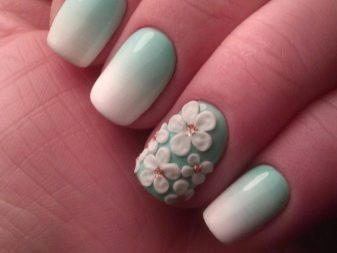
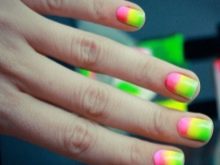
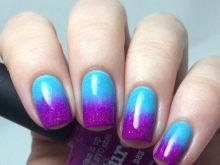
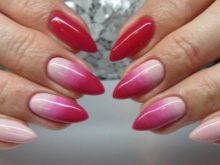
Vertical graduation also implies a transition of tones within the nail plate, but here the tones flow from right to left.Just as in the horizontal coating, three or more colors are used here, most often the little finger is completely painted in one color, a gradient is formed on the nameless marigold in a different tone, on the middle tone they pass from the one that we received on the nameless and etc. Such a manicure looks quite fresh and very stylish, and most importantly, very well-groomed and elegant.

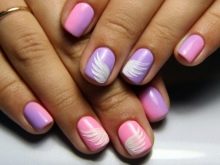

By the way, another rather original feature of gradients is the use of thermal varnishes, when the ambient temperature changes, they change shades and the coating plays with new unusual colors every time.
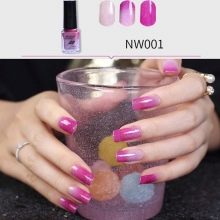

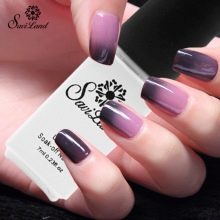
Coating options
When applying a gradient to marigolds, a variety of types of coatings are used.

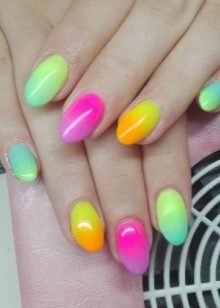
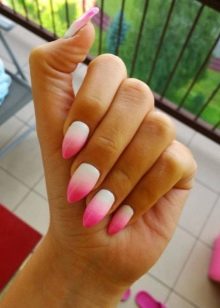
The most popular are gel varnishes, which in their essence are a kind of hybrid of ordinary varnish and acrylic paint. Distinctive features of such a composition are:
- high percentage of gel in the structure;
- much less harmful formaldehyde and toluene;
- when applying such a coating, the nail plate does not require preliminary grinding and filing, it is only cleaned and degreased, which means that the nails remain dense and healthy longer;
- to get rid of such a coating, you do not need to destroy it at all, it is enough to apply a remover - in this case, the gel polish will soak in literally 10 minutes.
Such varnish must be dried in an ultraviolet lamp, due to which it becomes so strong that the coating cannot be damaged even by very sharp objects.
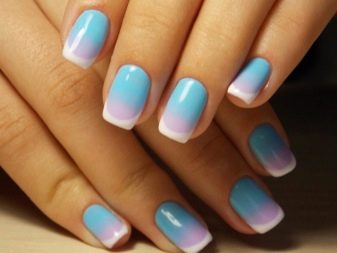
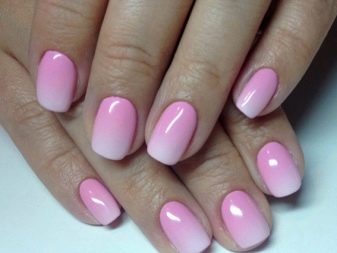
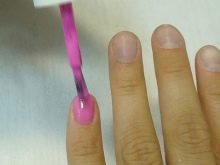
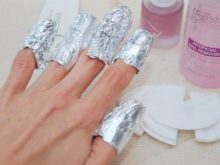

Vinylux is another popular gradient coating. Purely visually, it looks like a varnish familiar to everyone, but it has its own characteristic features that cannot be seen at first glance. At its core, this varnish is a two-phase tool, which includes a base - therefore, you do not need to apply a base to your nails.
Vinylux has a rather peculiar structure - its pigments are slightly larger than the size of the spaces between the keratin scales, so they are simply not able to paint the nail plate. The coating hardens in 10 minutes, while over time it only gets stronger.
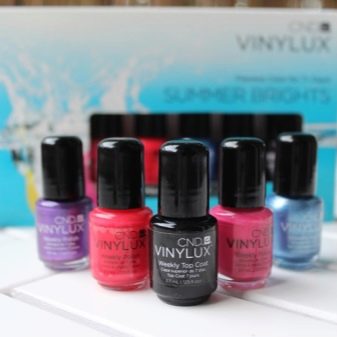
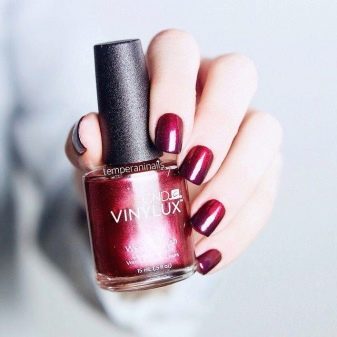
Some craftswomen try to use biogel for a gradient - this is a completely meaningless exercise, since it is designed to lengthen the nail plate or give it the desired shape, but not paint in any way.
Gel polish stays on nails for about 2-3 weeks, while it can withstand any, even the most adverse weather conditions.
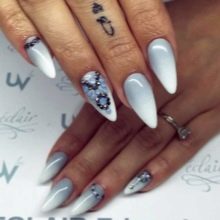
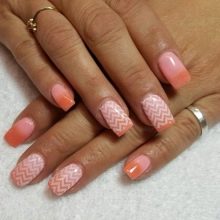

Vinilux is called "weekly" varnish - it is worn for 7 days, however, as practice shows, after 4-5 days, the first chips often appear, in addition, such a coating does not look aesthetically pleasing if the nails have at least minimal defects and damage.
And, of course, you can use the most common varnish to create a gradient, then you have to update it every 3-4 days, and most types of household chores (cleaning and washing dishes) have the most adverse effect on it.
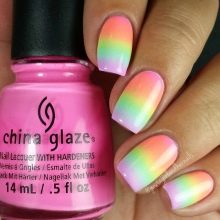
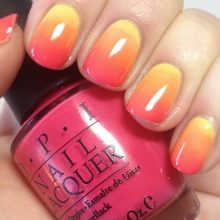
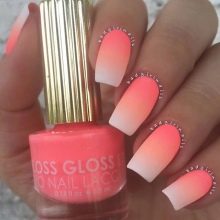
Trendy colors
For a long time, the gradient was performed in beige shades, stretching it from light milky to darker peach. Nowadays, the color palette used in degradation is limited only by the imagination and personal preferences of the owner of such a manicure.


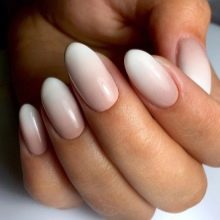
The stretch from blue to pink looks very gentle, the transition of shades from lilac to rich purple. But more daring girls combine almost incongruous, for example, green and red tones, or combine blue with yellow.


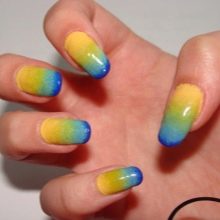
Quite popular in recent years is a colored manicure - a rainbow, as well as coatings with mirror rubs, which give the coating a metallic shade.
This manicure looks complete and extremely stylish.
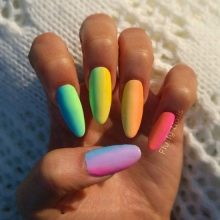

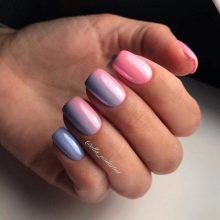
Methods of creation and required inventory
You can draw a gradient on the nails even at home, for this, you should prepare the main inventory:
- several types of varnishes of various shades;
- sponge / applicator / kitchen sponge;
- a wooden stick or a couple of toothpicks;
- degreaser, base coat, fixer;
- nail polish remover;
- corrector.

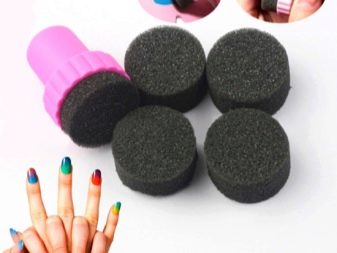

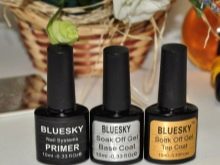
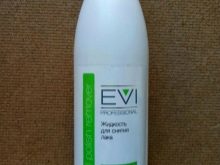
Stretching is quite easy to do if you use the most common nail polish, but there is also a "but" - such a manicure will last no more than 2-3 days. A gradient made with coatings on a gel base will be a little more durable, but it is also much more difficult to draw it.
Nail industry experts use several basic coating options, let's talk about the most popular ones.
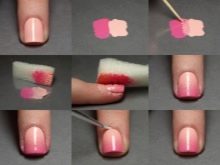
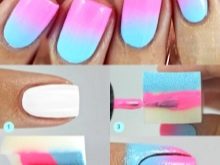

With a sponge
In order to create an ombre in this way, you need to prepare a piece of kitchen sponge or a cosmetic sponge.
First you need to decide on the shades that you plan to use in the decorative coating.
Next, a base is applied, which is designed to protect the nail plate, so that the gradient remains on the nails for a longer time.
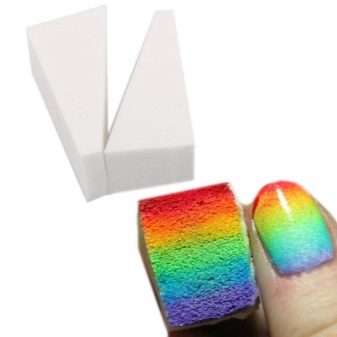
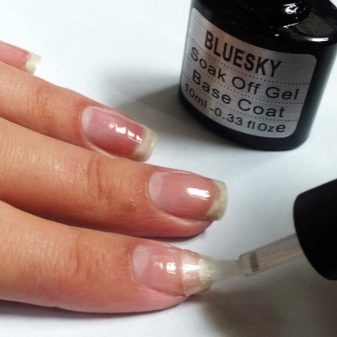
Then the lightest varnish is taken, they should completely cover the nail and let it dry.
After that, the sponge or sponge should be moistened with plain water so that the material becomes moistened and does not absorb the varnish. Then you should take varnishes and alternately apply them in stripes on the sponge, moving from the first tone to the second, while drawing them fairly confidently so that the lines touch each other slightly.
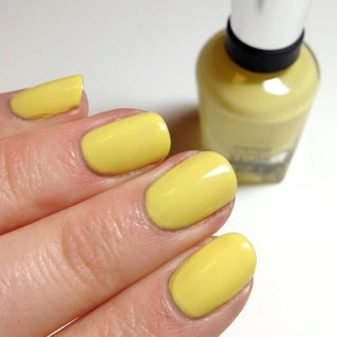
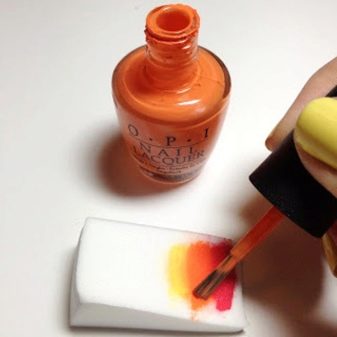
At this stage, a polyethylene film or foil may be required, from the contact of the spongy surface with them, the boundaries are blurred and thereby a smooth transition is formed; in order to make sure that the stretch is harmonious, you should check the effect obtained on paper.
If you are satisfied with the color scheme, you should proceed to the most difficult thing - transferring the coating to the nails. If you do not have much experience in manicure, then start with one nail with a few touches, while the sponge can be slightly shifted from one side to the other to obtain a more original result. Experts cope with this task with one touch.
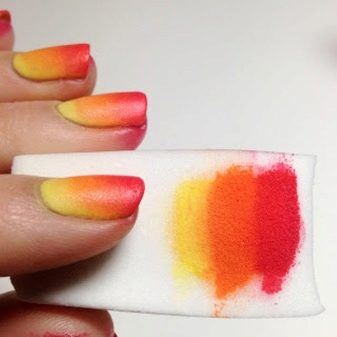
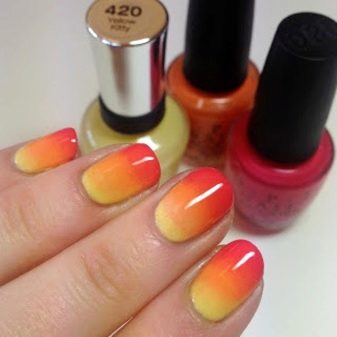
If the remnants of the varnish used get on the skin, then you need to get rid of them even before it dries completely, then you will need a special liquid or a corrector.
However, you can secure your fingers in advance - for this, tape is glued to them even before the plates are processed with a painted sponge.
To consolidate the effect, a top coat should be applied, which will give the manicure greater durability.
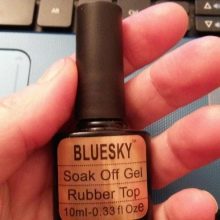
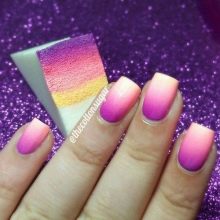
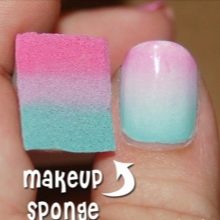
In this method, there is a little trick - in order to create a gradient, you can just apply a base shade to the plates, and another shade on the sponge - in the future you will print it on a clean edge.
The foil design is not very different from the one described above in terms of the underlying technology. The only difference is that if in the first case the varnishes are initially applied to the sponge, here they are applied to the foil. Keep in mind that you will need a flat surface for this.
The color transition is initially done using a sharp toothpick.

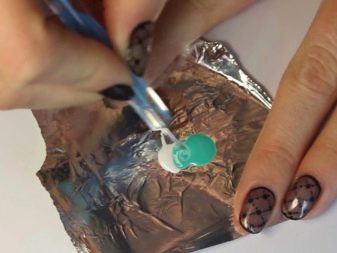
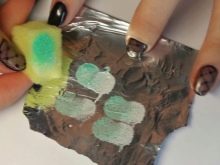
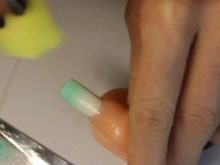

With applicator
This method uses an applicator for cosmetic shadows. And this technology is very similar to the first two, however, it is believed that the applicator is more comfortable than a sponge and sponge.
The order of manipulations in such a case is as follows:
To begin with, the cuticle and keratinized areas of the skin near the nail plates are removed.
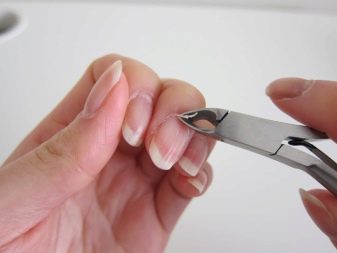

Nails are painted with base varnish and only after it dries is the edge of the plate covered with one of the varnishes used, and the second is applied to the applicator, it is imprinted at some distance. Depending on the total number of desired shades, the steps are repeated.
At the final stage, it is imperative to remove the remaining coating from the fingers and apply a layer of fixer.
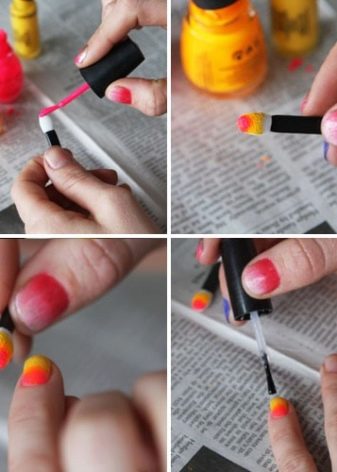
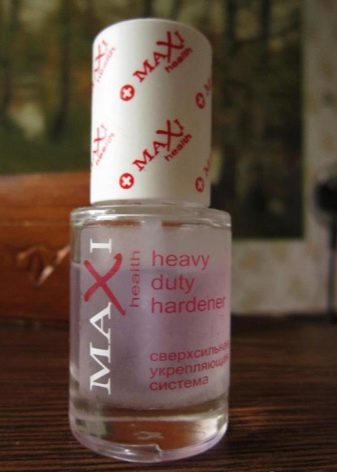
With a brush
This application method is considered to be one of the simplest, because to create a beautiful gradient you only need a brush with soft bristles.
On previously cleaned and degreased nails, it is necessary to apply a thin layer of the selected shades of varnishes, then the brush is dipped into the cleaner and then, until the varnishes are completely dry, a number of quick movements are made along the nail plate in those places where there should be a transition of shades from one to another.

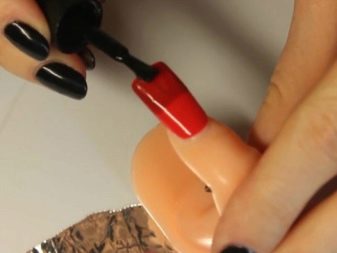

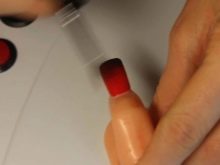
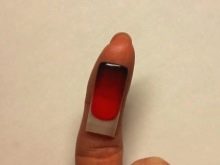
After each such shading, the brush should be wiped with a napkin without fail, if you do not have much experience in applying ombre, it is better to give preference to a fan brush. However, the procedure in this case will be slightly different - this brush does not make a soft transition, so it is better to mix the middle, transitional tone yourself, connecting the main tones, apply all the colors on the nails with a brush wet from the clinser, and make movements similar to strokes broom and repeat until the desired effect appears.
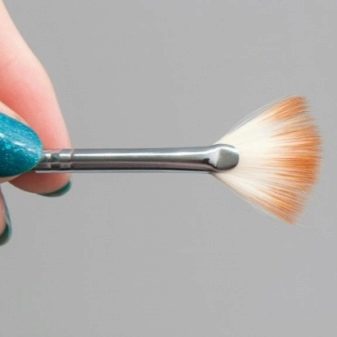
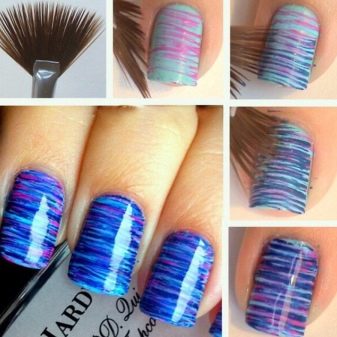
Coating with gel varnish
As we already mentioned, such a graduated coating lasts much longer, in addition, it does not have the unpleasant property of peeling off in pieces and peeling around the edges, as is often the case with conventional varnishes.
Before making a gradient manicure, the nail plate should be cleaned, degreased and lightly sanded, then remove the remaining nail dust and send your hands to dry in a special lamp.
After that, the surface of the nails must be covered with a base coat, after which it polymerizes rather quickly, and the sticky top layer is removed with any lint-free napkin.
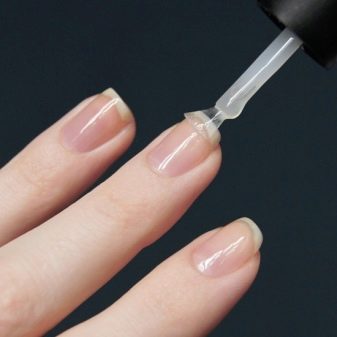
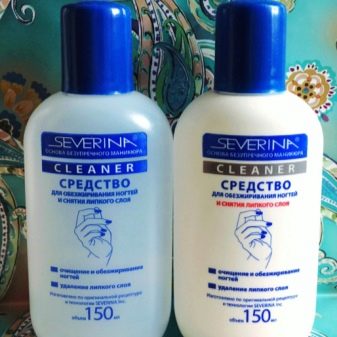
When the nails are fully prepared for staining, one should apply gel polish of one shade on one side, and the other on the other, after which a smooth stretch between the tones is drawn with a very thin brush.
At the end, the nails are again sent for drying, the sticky residues are removed and a top-end fixing coating is applied on top.
Keep in mind that when curing, you should not keep your nails under the light of the lamp for more than two minutes.
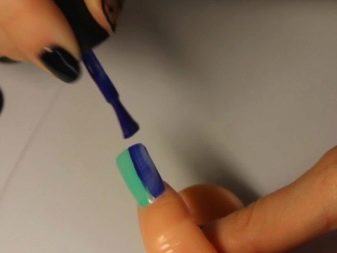
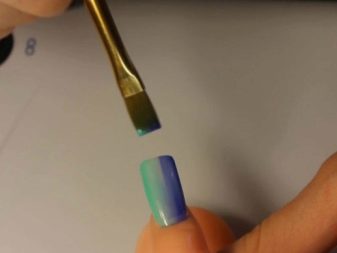

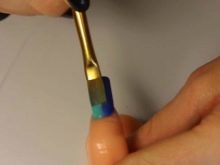
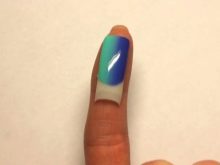
In recent years, the geometric gradient has become very popular., it is performed with a rather thin brush. For such a coating, you should prepare a couple of gel polishes, while one should be white, and the second more saturated and bright. By gradually diluting shellac of a bright shade with white, you will get more and more delicate light colors - they should be used to display various geometric shapes from light to dark. In this case, all layers are applied very thinly, after each application, drying is not required - the hand should be placed in a UV lamp only after you have finished the whole drawing.
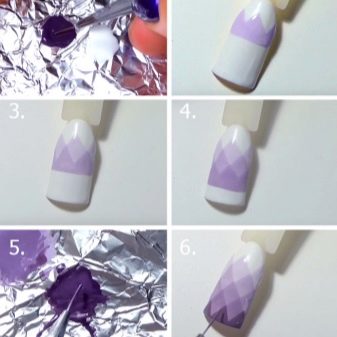
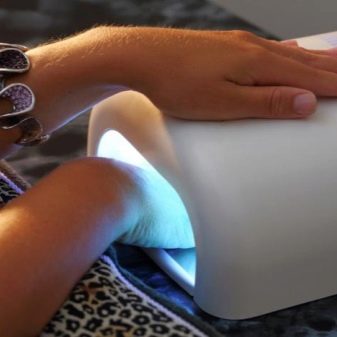
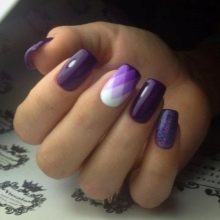
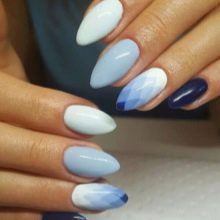
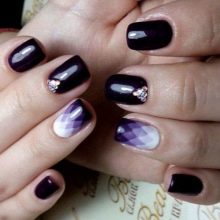
In the current season, at the peak of popularity is the gradient made in the form of rhombuses.
However, such a pattern can be applied with ordinary varnish, although it dries out rather quickly and therefore its use will be rather difficult. In this case, you are better off using special stencils with various patterns that allow you to realize the most daring design ideas.
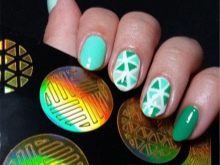
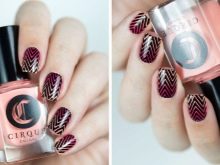
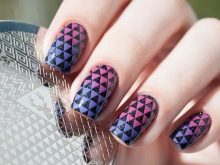
Some girls use stencils in working with gel polishes. - this is not entirely correct, since shellac tends to flow under the stencil, so the effect may turn out to be completely different from what you plan.
Professionals in nail service salons use special machines and sprayers when performing degradation.
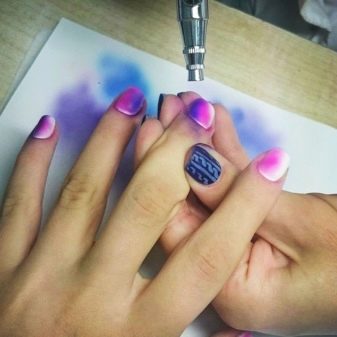
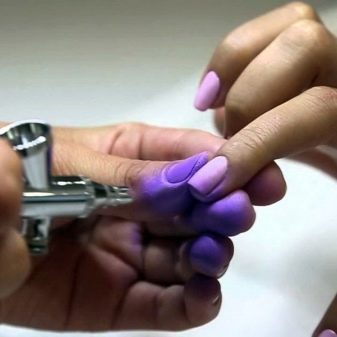
Popular nail design ideas
In conclusion, let's dwell on the most trendy nail art design options using the ombre technique.
- Classical - in this case, the gradient is applied on one nail vertically or horizontally.

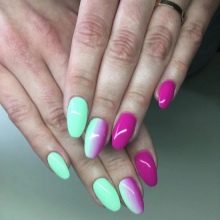
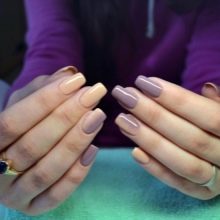
- French technique - the basic principle here remains unchanged, however, beige or light pink colors are taken as the main shades, which smoothly turn into milky or white within one nail plate.
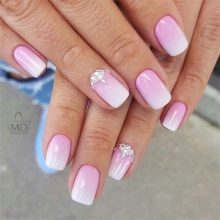
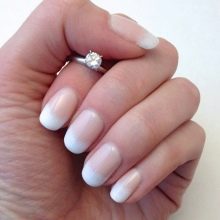
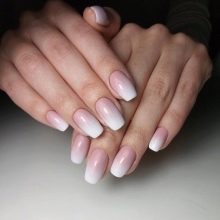
- Gradient with art painting - in this case, the coating is used as a field for drawing interesting pictures.
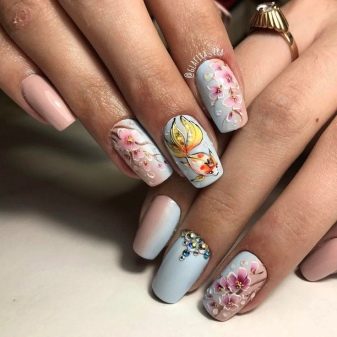
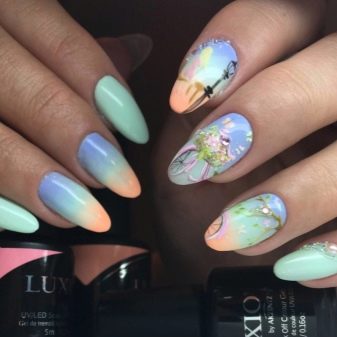
- Shining - here the graduation looks a little different. Nails are covered with only one shade of varnish, while the gradient is performed using glitter, the number of which is reduced from the edge of the nail to the cuticle or vice versa.
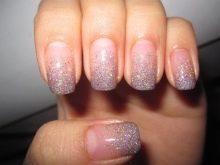
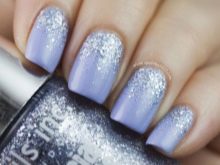
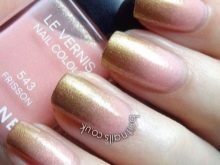
- Chaotic - in this case, the border of the transition points are located absolutely in any area, and the applied colors themselves quite often change direction. An example is the Skitles nail design, which got its name from the name of all known sweets - everyone knows how these sweets behave when they are in milk.
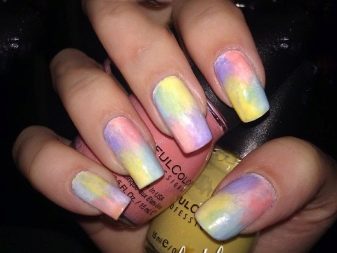
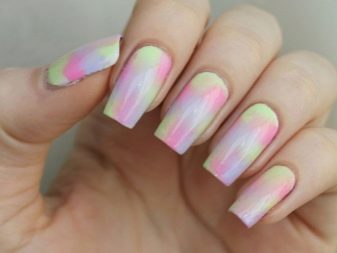
- Linear - such decor is represented by simple lines applied vertically with thin brushes. With this decor, there is no blur between the borders of the shades.
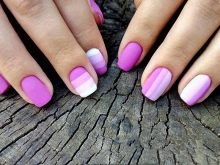
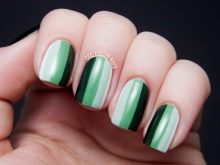
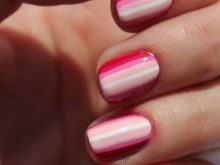
For information on how to make a gradient manicure with stamping, see the next video.








